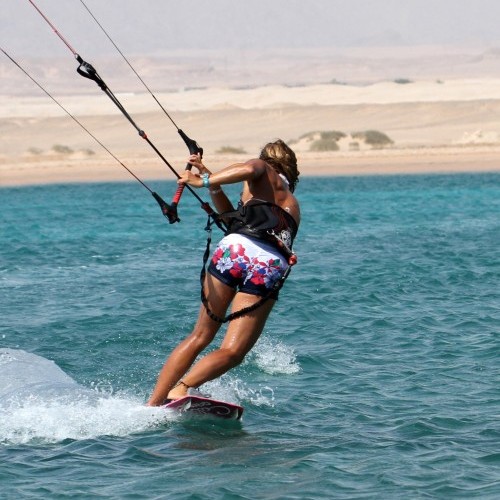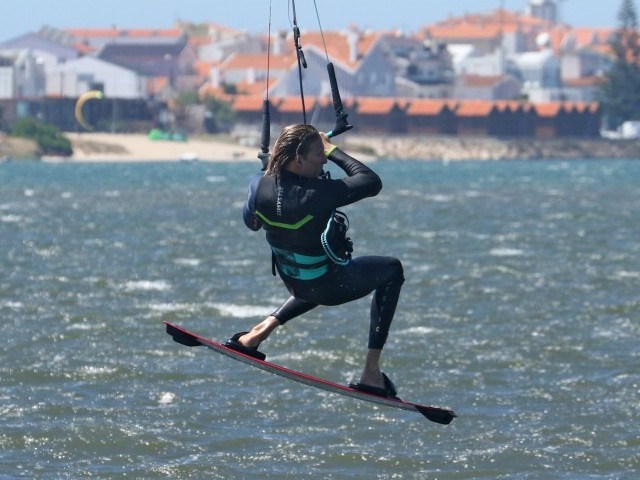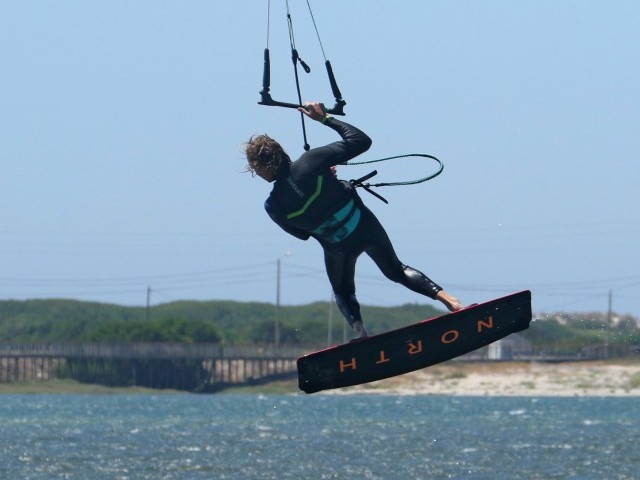
Blind to Toeside Carve
Technique / Intermediate
Introduction
Continuing along the path of hooked in moves to keep you busy and anything to and from blind here is a cheeky blind turn. Blind is sometimes described as toeside backwards, and this demonstrates it nicely. At the beginning it’s basically a slide turn from blind, which you come out of carving on your toes, but once you perfect it, you’ll be carving into the wind and them hammering off onto your toes with no slide – reverse in and forward out.
This can of course be used on its own in preference to just sliding back round, or as something at the end of a to blind move to make a cheeky combo. Apart from that this is a great way to bully yourself into getting two hands onto the bar in preparation for all sorts of “from blind” moves!
The foundations for this move are of course a solid blind, and if you can find some flattish water it will certainly make life less challenging. So must be the moment for a quick reminder and a look at the finer points involved in this turn!
Approach
Karine is riding towards the camera on a very solid blind edge. If we start at the top she is definitely not looking where she’s going, but rather back from whence she came. This prevents her from twisting around and sliding off her edge. She has her kite around 11 o’clock, or lower, which enables her to lean against it and maintain power. Any higher and she’d struggle to keep her forward speed. Her front hand is centred on the bar so that she can pull the bar in and keep tension in the lines and drive in the kite. Her hips and knees are facing and pointing upwind to position her weight against the edge of the board. Her back (left) leg is bent and her shoulders are leaning over the tail of the board, to keep her weight over the tail, so the board rides along in its usual nose up way, and therefore won’t catch or trip.
Getting your Other Hand on the Bar
Pic B. Getting your free and swinging hand back on the bar so that you can control the kite is essential for this move and any other from blind move. Without two hands on the bar you’ll have no way of really controlling the kite. The first key point here has to be trim. If your bar is trimmed miles away from the chicken loop and you have to reach for it this will twist your body out of your blind riding position, so in old money – de-power your kite. Starting at the top again Karine is still not looking where she is going, and not even looking around to see where the bar is, if she does she risks sliding the board out of blind. Her front hand has pulled the bar in towards her. This is only possible because she has trimmed the kite. If not the kite would pull her up off her edge and dive down onto the surface. With the bar within reach Karine lifts her free hand and grabs it. This is well worth practicing on a bar at home, or with your kite in the air whilst standing in the shallows. Physically you can’t reach too far so the trim will make all the difference.
Carving into Wind
Pic C. In principle you need to approach this as you would a slide turn. So your aim is to scrub off speed by heading upwind, and then move your weight across towards the noise of the board so that you are ready to head off in the opposite direction. Here we can see Karine as she starts to carve the board upwind. Firstly note that up top nothing much has changed, her head and shoulders are still over the back of the board and facing backwards, as she still needs her weight over the tail of the board. However the main difference is that she is pushing against the board with her back (left) leg, to edge harder. You can see that the leg is straighter, and as long as Karine’s weight stays back this will dig the edge in and the board will turn and slow. Once it does slow Karine must then start to drift the kite up and get her weight forward onto her front (right) foot so that she will be ready to head off in the new direction. When you do this at first the board will then slide, as you would expect just as in a slide turn, weight forward, push on the back leg and slide!
Carving Down onto your Toes
Pic D. This moment is the transition from upwind carve to downwind carve. As soon the board has slowed and Karine has her completely moved her weight onto her right leg, has her left leg extended she then dives the kite across the window to pull her out of the turn and downwind on her toeside edge. It’s imperative that throughout the move she keeps looking back to where she came from and to where she intends to go.
Top Tips
Bar trim wins here every time, as without it there’ll be no two handed joy.
You may have to experiment a tad to find the best balance of weight, so that you can drive against your back leg to turn the board upwind without sliding the fin out. The golden rule is to keep your weight where it is for riding blind and then push the back leg away from under you without pushing your weight forwards. Releasing some pull from the kite by pushing the bar away slightly can help here.
Following Sequence 1
Pic 1. Karine has popped to blind with some speed, her kite around 11 o’clock and has got her free hand back on the bar whilst still looking behind her, helped no end by having the bar trimmed in!
Pic 2. Karine now starts to push against her back trailing foot in an effort to turn the board upwind and loose some speed. She doesn’t turn to look at the kite as this will slide the board back around.
Pic 3. As the board turns upwind and slows Karine simultaneously starts to drift the kite up by pulling on her trailing hand, and moves her weight and hips over her leading foot by extending her trailing leg.
Pic 4. With her weight now forward, the tail of the board begins to slide, so Karine keeps looking back and towards where she intends to go. If she were to turn and look towards the camera the board would slide back to heelside.
Pic 5. With the board now ready to head downwind Karine dives the kite across the window with her new front hand.
Pic 6. As the power comes on Karine drops her hips further back against the pull.
Pic 7. And gets her weight onto her toes to engage her edge.
Pic 8. So that she can ride out with speed on toeside!
Common Problems
If you keep sliding around from toeside as you reach for the bar with your free hand. This invariably means that you are turning your head to look at the bar, which encourages the body and board to untwist. Once again make sure that the bar is trimmed in enough so that you can reach it.
If you slide back around to heelside, before going downwind onto your toes. Once again keep looking back and once you’re heading upwind be aggressive with bringing the kite across the window, and don’t let it go up to 12 o’clock.
Keystones
- Trim the bar
- Speed to a good edged blind
- Reach for bar without looking for bar
- Push against back foot to slow and turn
- Dive kite hard
This technique article was in Issue 29 of IKSURFMAG.
Related
By Christian and Karine
Christian and Karine have been working together as a coaching team, running improver to advanced kitesurfing clinics since 2003.


























